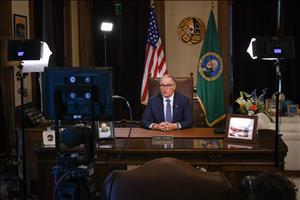Washington residents begin a period of COVID-19 isolation when Governor Jay Inslee (b. 1951) issues a statewide "Stay Home-Stay Healthy" order on March 23, 2020. The order changes life fundamentally for every state resident. It inaugurates a long period of sheltering-in-place, in which residents are prohibited from leaving their homes except "to conduct or participate in essential activities" or to work in "essential business services" ("Proclamation"). Essential activities are largely limited to buying groceries, seeking medical help, and exercising outdoors. The list of essential businesses is long, but most businesses in the state are ordered to shut down on March 25. The purpose of the order is to stop the spread of Coronavirus Disease 2019 (COVID-19). Inslee's proclamation comes on a day when Washington's confirmed cases have reached 2,221 and the death toll hits 110.
'It's Time to Hunker Down'
Normal life in Washington had already veered off course weeks earlier. Washington had the nation's first reported case of COVID-19 on January 20, 2020, and the first reported deaths on February 26. On February 29, Inslee declared a statewide state of emergency. On March 11, he banned large gatherings. On March 13, he ordered all schools in the state closed. On March 16, he ordered all restaurants, bars, and recreational facilities closed.
So by the time the Stay Home-Stay Healthy order arrived on March 23, most Washington residents had been practicing forms of social-distancing for weeks. Data collected from cell phones by Google indicated that by March 6 "a quarter of Seattleites" were already avoiding their workplaces (Duhigg).
Yet the Stay Home-Stay Healthy order was of an entirely different magnitude. In essence, it meant that most people were ordered to shelter-in-place in their homes -- not go to work, not visit friends, not drive, not travel, and not shop, except for essentials. The majority of Washington's 7.6 million residents began weeks of isolating in their homes, working remotely or not at all, and venturing out only to grocery stores and pharmacies.
"It's time to hunker down to win this fight," Inslee said in a televised address on March 24. "... The less time you spend out in public, the more lives we can save; the more time we can buy to fight the waves coming down on us now and in the immediate future" (Address transcript).
On March 24, Seattle's downtown streets were eerily empty. The Boeing Company's assembly lines were shut down. Leavenworth, normally crawling with tourists, looked like a "ghost town" (Hanson). Walla Walla looked "like the sleepy ghost town it used to be" (Hanson). Business districts all over the state would remain largely deserted in the coming weeks.
Inslee, in issuing the order, was aware of the damage it would do to the state's economy. "I make this difficult choice knowing it will add to the economic and family hardship many in our state are already feeling as we try to slow and turn back this pandemic," he said in his address. "We want to get back to normal as soon as possible. We don't want this to be a lingering intrusion in our lives. The fastest way to get back to normal is to hit this hard" (Address transcript).
Perhaps because of Washington's early cases and deaths, residents seemed to understand the gravity of the situation. Washington residents largely complied and accepted the inevitable sacrifices. In one telling statistic, gasoline sales in the Seattle area dropped by two thirds in the week after the order.
The economic damage was immediate and stunning. By mid-April, more than 500,000 Washington residents had applied for unemployment compensation. Many industries were nearly at a standstill, including manufacturing, construction, food service, and retail trade. Most offices and workplaces were deserted, as employees worked remotely -- or were furloughed. Almost the only places in Washington that looked busy were the walking and jogging trails, as cooped-up people craved exercise.
Washington was not the first state to issue a stay-home order -- California issued the nation's first on March 19 – but it was one of only nine states to do so by March 23. By March 30, a total of 30 states had issued similar orders. The Washington order was effective through April 6, 2020, but would later be extended through May 4, and then extended again through May 31, with some restrictions lifted or modified.
As painful as it was, the Stay Home-Stay Healthy order accomplished its primary goal, to slow the spread of the disease. State statistics showed that daily reported cases peaked at 435 on March 23, and then steadily receded to around half that within a month. Daily reported deaths peaked at 29 in late March, and slowly receded into single digits. By late April, Washington went from being the U.S. epicenter of the disease to having only 2 percent of the nation's cases.
This allowed Inslee to begin loosening restrictions in late April and early May on construction, outdoor recreation, and elective surgeries. Yet Inslee warned that this was not a "return to normal" ("Inslee Announces Easing"). Because there were still new cases and new deaths, most of the Stay Home-Stay Healthy order was extended through May. Hunkering down at home remained the order of the day.
Next: A COVID-19 outbreak at the Spokane Veterans Home claims its first victim on April 8, 2020.

